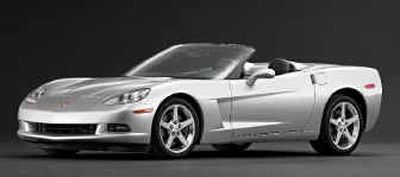Tantalizing new Corvette worth wait

If all GM cars were as good as the new Corvette, the company’s troubles would vanish like taillights into the horizon.
The 2005 ‘Vette is the product of more than 50 years’ experience, six generations of development and a single-minded focus. It has not always been a great sports car but has become one; it serves as a reminder of what GM can do when it sets its best minds and resources to the task.
In fact, the introduction of the C6 was put off when then-new Chevy GM Bob Lutz declared it unready, delaying production by a year. That decision frustrated customers and dealers but the wait was worth it.
For most of its 50 years, the Corvette was more muscle car in disguise than sports car. In stock form, getting it through a corner quickly meant manhandling the steering wheel, and stopping played second fiddle to going quickly.
Build-quality was never a strong point, either. Most vintage ‘Vettes are a one-instrument symphony of squeaks and rattles.
Things started to change in a serious way in 1997, with the introduction of the fifth-generation, C5 Corvette. More refined and powerful than its predecessors, the C5 held its own on the racetrack without undergoing major suspension and tire modifications.
The process has continued into the sixth generation and, if the next step is as dramatic, Porsche and Ferrari may have to get accustomed to watching taillights disappear.
Because it rides on the same platform and shares its basic shape and many components with the C5, the C6 is considered an evolutionary vehicle.
If so, it’s an evolutionary leap. The wheelbase has grown, the car has shrunk and designers hit the mark in terms of balance. The C6 weighs in at a near-perfect front-to-rear weight distribution of 51/49, a key prognosticator of handling efficiency.
Five inches shorter than before and an inch narrower, its footprint is nearly identical to that of its chief rival, Porsche’s 911. And the ‘Vette is only marginally heavier than the 911.
Long-legged types will be glad to know that most of the loss of length came from trimming the overhangs; the cockpit retains the roomy-yet-intimate dimensions of the C5.
Regrettably, the interior lets down the team. At these prices (coupes start at $44,510, including destination; convertibles at $52,245), buyers should get more than a standard-issue GM interior. Fit-and-finish far outstrips earlier iterations, but our convertible tester bashed the gong at $62,280, and for those dollars a better grade of leather and more supportive seats should be de rigeur.
Still, I hadn’t lowered myself into this beast to be coddled; I was here for the thrills, plain and simple.
They start with a switch of the ignition; the small-block eight turns over easily and settles into a relaxed rumble. A couple blips of the throttle produce a tantalizing rise in the decibels, with a satisfying swing of the tachometer needle.
The long-throw clutch engages easily and the newly revised short-throw shifter engages the six forward gears cleanly and accurately. Maybe it’s my imagination, but the skip-shift device that at light throttle forces a fuel-saving first-to-fourth shift seems less intrusive than in previous editions.
That’s probably the result of this engine’s efficiency; it’s rated 18 city/28 highway, which verges on the miraculous in a 400-horsepower vehicle.
It’s all the more miraculous, considering that the C6 will accelerates from zero-to-60 in a tick or two less than 4.5 seconds. In a straight line, it makes 100 mph in less than 10 seconds and the quarter mile in less than 13. If the driver doesn’t lift her right foot, it won’t quit until it reaches 186 mph.
Of course, inquiring minds want to know how the ‘Vette behaves on the track, the only place it can be driven at its limits. A few years ago, I spent the better part of a weekend on a track in a Z06 coupe, the hot-shoe edition of the C5. The base C6 is at least the equal of that car, which was more nimble and compliant than I had expected. It was remarkably forgiving at the limits and an abundance of torque, which is available across a wide power band, covered up all but the most egregious cornering errors.
A Porsche grows around the driver like a second skin. It seems to intuit what the driver wants next. Its power comes on in a spooling rush and it attacks with a rasping whine.
The Corvette is different. It’s guttural, deep and a little distant. The throttle has a heft and something like resistance underfoot, a tool to be bullied. Lay into it and the car hurtles violently forward. Light understeer at a corner’s entrance and moderate oversteer allow the car to be driven hard into an apex without plowing or threatening to spin. Overcook it and a touch of throttle brings the back end into line.
Most drivers will never approach this car’s limits but they can rest assured that their car is capable of terrific levels of performance.
Like the other American sports car, the Dodge Viper, the Corvette accomplishes its magic with displacement and straightforward pushrod engine technology. Other cars may outperform it at the edge, but, as Road & Track magazine argued recently, while naming it best all-around sports car, the Corvette may be the best value available among two-place sports cars.
It may never be as sophisticated as its high-toned European competitors, but Corvette fans will tell you that’s a fair trade for affordable world-class performance.
General Motors is confident of renewed glory and if the ‘05 Corvette is an indication of what’s ahead, Lutz & Co. may prove to be the winners in the long run.